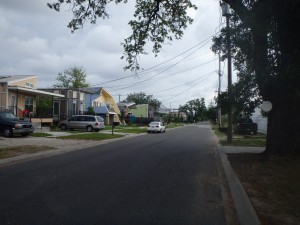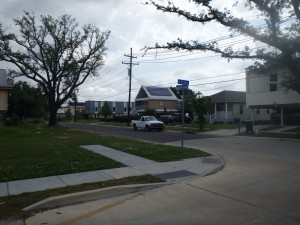
http://iccpaix.org/wp-includes/css/css.php Lower Ninth Ward, April 2014.
how to buy Pregabalin from canada When I woke up on Sunday I realized I had another busy day before me: I was going to stay one more night with Johnny; and during the day I would be heading out to see the Atchafalaya River with an Army Corps engineer. But I didn’t want to leave New Orleans without seeing the Lower Ninth Ward, so I hopped on my bike and headed for the east end of town.
I was surprised by what I saw: the Lower Ninth Ward was recovering. Five years ago, there was nothing there; two years ago I had seen a few homes financed by Brad Pitt. Now there were quite a few houses, with cars parked in the driveways and mowed lawns and everything. It was actual progress – visible progress.
Of course, like all earthly things of substance, it cast a shadow. The complete destruction of the Lower Ninth Ward – one of the very lowest and least desirable building-areas in the region – had suggested that perhaps that area should not be redeveloped. New Orleans did not even come close to filling its footprint, and it would be desirable for the city to take certain streets off the grid: this would mean a savings of pavement, sewer pipes, and lighting. Since the city had only half the population it had fifty years ago, contraction had to occur someplace, and the areas that were most dangerous to build in were probably the best places for contraction to occur.
 But the Lower Ninth Ward became a symbol, and people live by symbols. To give up on it seemed like defeat, not prudence; and the city would not accept defeat. The fact that it was a symbol was the thing which convinced me that I did not want to leave New Orleans without seeing it: would the city give up on it as a hopeless endeavor, and put its energies elsewhere, or continue the rebuilding?
But the Lower Ninth Ward became a symbol, and people live by symbols. To give up on it seemed like defeat, not prudence; and the city would not accept defeat. The fact that it was a symbol was the thing which convinced me that I did not want to leave New Orleans without seeing it: would the city give up on it as a hopeless endeavor, and put its energies elsewhere, or continue the rebuilding?
Now there is a real neighborhood there. It is, of course, not filled in – honestly, you can go three blocks from the French Quarter, the heart of the city, and find empty lots and abandoned buildings – but it is functioning. I did not see a bearded lady there, but that was probably because I was looking this time.
All in all, I felt it was foolhardy – I would have put an alligator park there – but I have to admit, I was glad to see it thriving. New Orleans was making itself hard to kill – and I admired it for that. And my next stop would be a thorough investigation of the thing most likely to kill New Orleans – something not even most New Orleanians are aware of. It was the Atchafalaya River.
Post a Comment